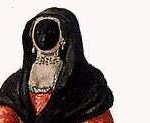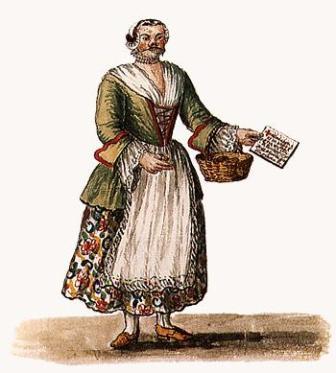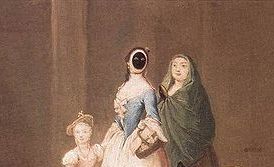
There are just too many curious things about the way Carnival was back in the Great Days, so I’m only going to tell you a few of the ones I think are interesting. Anyway, it’s not as if they have any relevance now. For all the roar of media coverage today, what goes on here is a hoarse whisper compared to the cacophony that was Carnival before 1797.
And Paris must be deserted; there are nothing but French people in town.
For many centuries, Carnival here was primarily a Venetian phenomenon, which is to say an integral part of Venetian life and culture. But when Vasco da Gama reached the Spice Islands by means of a daring new route round the Cape of Good Hope (1497), Venice’s monopoly of the spice trade collapsed virtually overnight, dragging the city’s economy down with it.
Struggling to get the city back on its feet, somebody began to put the word out that the Venice Carnival was one heck of a thing to see. Yes, Venice could discern its potential for tourism even before the invention of bullets and parachutes, and the Venetian merchants, staring into their now-empty coffers, were quick to make the most of it.
- Costumes: People would dress up as virtually anything, from a classic character such as Pulcinella (from Naples) or Arlecchino (from Bergamo) to plague victims, blind people, cripples, Jews, Turks, lepers, peasants from Friuli, men dressed as women. These were known as “Gnaga” ( NYAH-ga) and had their own particular mask to go with their feminine clothes. The mask was meant to resemble a cat, and the person would meow instead of talking. (It must have looked great on a person with a beard.) The gnaga also carried a little cat in a basket, or sometimes even a tiny baby, or he/she’d be accompanied by men dressed as babies. Don’t ask me.
A "gnaga" with a suspiciously empty basket (Giovanni Grevenbroch, 18th century).
The wildly absurd and equally wildly obscene elements which so many favored (I refer to behavior as much as garb) were not simply a crucial social safety valve (keeping in mind that the patricians lived with loads of restrictions, too — it wasn’t just the salt of the earth that needed a break). It appears that people have always exploited the absurd and the obscene as a way of exorcising their dread of death and the demonic, and Carnival was the Olympics of spitting in the face of fear, as well as in the face of manners and rules and occasionally, I imagine, other people.
Sir Thomas More famously stated that “The devil, a proud spirit, cannot endure to be mocked,” so the broader, sharper, and deeper the derision, the better. That went double for the rude and the lewd. So really, unless you were putting somebody life or savings in danger, there was no such thing as too wild, too crude, too raunchy– too anything. They organized races for boats rowed by dwarfs, or the blind.
- Masks: There is a universe of lore about their meaning, their function, etc. Did you know that…
The white mask often called a bauta is more correctly termed “Volto“ (face) or “Larva.” Sounds repellent, but it comes from the Latin meaning ghost, specter, minor evil spirit. Its extraordinary shape resolves several important concerns: First, it completely hides the face; second, it leaves space for the wearer to eat and drink; third, its shape alters the speaker’s voice, thereby acting as a kind of vocal, as well as visual, disguise.

I can see what the appeal would be for men, but if you couldn’t speak, why would you go visit someone in a convent in the first place? To give the nuns a chance to talk?


 The white mask often called a bauta is more correctly termed “Volto“ (face) or “Larva.” Sounds repellent, but it comes from the Latin meaning ghost, specter, minor evil spirit. Its extraordinary shape resolves several important concerns: First, it completely hides the face; second, it leaves space for the wearer to eat and drink; third, its shape alters the speaker’s voice, thereby acting as a kind of vocal, as well as visual, disguise.
The white mask often called a bauta is more correctly termed “Volto“ (face) or “Larva.” Sounds repellent, but it comes from the Latin meaning ghost, specter, minor evil spirit. Its extraordinary shape resolves several important concerns: First, it completely hides the face; second, it leaves space for the wearer to eat and drink; third, its shape alters the speaker’s voice, thereby acting as a kind of vocal, as well as visual, disguise. 